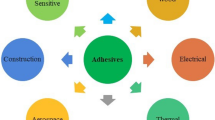Abstract
Addition of succinaldehyde to UF resins for plywood directly in the glue-mix improves markedly the water resistance of the hardened UF glue line in plywood as well as diminishing its formaldehyde emission. Best water resistance results are obtained by adding small amounts of succinaldehyde: in the present study optimum water resistance was obtained for a urea-formaldehyde-succinaldehyde (UFSA) resin of U:F:SA molar ratio of 1∶1.3∶0.2. Increasing the proportion of formaldehyde substitution by succinaldehyde does not improve water resistance, but rather the water resistance deteriorates indicating that: or the excess of succinaldehyde is not able to copolymerise in the hardening UF network, or that the excess of dimethylene chains of the aldehyde decreases excessively the cross-linking density per unit volume of the hardened resin network. C-13 NMR analysis of a hardened UFSA resin indicated that the improved water resistance can be ascribed to the presence of the dimethylene chains coming from the aldehyde portion which is capable of copolymerising with the UF resin. Deterioration of water resistance by strong increase of the amount of wheat flour filler affects considerably less the UFSA resins than the UF resins.
Zusammenfassung
Zugabe von Succinaldehyd zu UF-Klebern für Sperrholz unmittelbar zur Harzmischung verbessert deutlich die Wasserbeständigkeit der ausgehärteten Leimfugen in Sperrholz und vermindert zudem die Abgabe von Form-aldehyd. Die beste Wasserbeständigkeit wird durch geringe Zusätze von Succinaldehyd (SA) erreicht. Die optimale Zusammensetzung eines UFSA-Gemisches ist zum gegenwärtigen Zeitpunkt U:F:SA=1∶1,3∶0,2. Eine weitere Substitution des Formaldehyds durch Succinaldehyd verbessert nicht die Wasserbeständigkeit sondern verringert sie eher. Das bedeutet, daß entweder der überschüssige SA nicht mit dem UF-Netzwerk copolymerisieren kann, oder daß durch die überschüssigen Dimethylenketten die Dichte der Quervernetzungen des ausgehärteten Harzes empfindlich herabgesetzt wird. C-13 NMR-Analysen des ausgehärteten Harzes zeigen, daß die erhöhte Wasserbeständigkeit auf der Anwesenheit von Dimethylenketten beruht, die durch Copolymerisation des Sa mit dem UF-Harz entstehen. Durch einen stark erhöhten Zusatz von Weizenmehl als Füller wird die Wasserbeständigkeit herabgesetzt, jedoch weniger als im Falle des nicht substituierten UF-Harzes.
Similar content being viewed by others
References
Breitmaier, E.;Voelter W., 1987: Carbon-13 NMR Spectroscopy, 3rd Edition, VCH, Weinheim
Ebewele, R. O.;Myers, G. E.;River, B. H.;Koutsky, J. A. 1991a: Polyamine modified urea-formaldehyde resins I: Synthesis, structure and properties, J. Appl. Polymer Sci., 42: 2997–3004
Ebewele, R. O.;River, B. H.;Myers, G. E.;Koutsky, J. A. 1991b: Polyamine modified urea-formaldehyde resins II: Resistance to stress induced by moisture cycling of solid wood joints and particleboard, J. Appl. Polymer Sci., 43: 1483–1490
European Norm UNI EN 314, pretreatment 5.1.3, Plywood bonding quality (1993).
Pizzi, A. 1994: Advanced Wood Adhesives Technology. Marcel Dekker Inc., New York.
Prestifilippo, M.; Pizzi, A.; Norback, H.; Lavisci, P. 1996: Low addition of melamine salts for improved UF adhesives water resistance, Holz Roh-Werkstoff, in press
Tomita, B.;Hatono, S. 1993: Urea-formaldehyde resins III: Constitutional characterization by13C Fourier transform NMR spectroscopy. J. Polymer Sci., 16: 2509–2517
Wang, S.; Pizzi, A. 1996: unpublished results
Author information
Authors and Affiliations
Rights and permissions
About this article
Cite this article
Wang, S., Pizzi, A. Succinaldehyde induced water resistance improvements of UF wood adhesives. Holz als Roh- und Werkstoff 55, 9–12 (1997). https://doi.org/10.1007/s001070050216
Issue Date:
DOI: https://doi.org/10.1007/s001070050216




